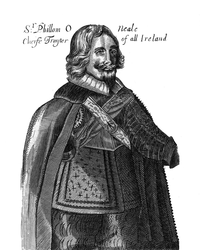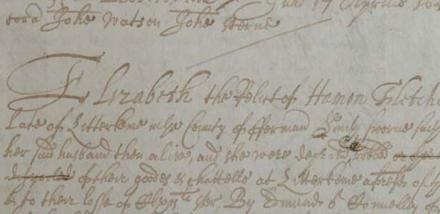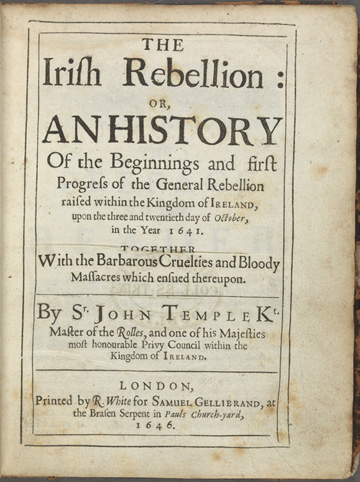
The gruesome murder of the Protestant Minister, Mr Blandry in Ulster in 1641. (Image from Trinity College, Dublin)
‘Be careful what you do or you’ll meet the murdered man on a black horse.’
In the 1940s, this warning was given to children living near Churchtown North by the Two Mile Inn just east of Midleton. In fact it applied to the road running from the graveyard at Churchtown (North) to Kilmountain Cross, the L3627, although I have no idea if it applied to the continuation of the same road beyond Kilmountain Cross towards Mogeely. I first heard this warning at the beginning of December 2018, followed by the question ‘who was the murdered man?’
Having attended the Midleton Library launch of Peter O’Shea’s book Murder Most Local, which recounts the stories of murders in East Cork from the early 1730s to the 1930s, I thought I’d bring the story back further. Peter noted that, thankfully, East Cork seemed to have been a lot less murderous than West Cork for which several volumes could be written just on the subject of local murder alone!
Let’s look at the introductory statement again – a murdered man on a black horse. These are very specific details. How did the local people know the man had been murdered? There seem to be no visible or gruesome details in the story. What about the ‘black horse’? Why specifically that colour? Even in the 1940s, before rural electrification, a brown or dun coloured horse would look black at night, but the detail is remarkably clear – the horse was definitely black.
The trouble with folklore is that it can be annoyingly unspecific and therefore difficult to pin down. Folklorists generally agree that such stories as the one noted above may contain a garbled verbal memory of something that happened ‘long ago.’ The challenge is to identify a specific incident that may be referred to in the local folklore. In the case under discussion, we may actually have an incident that is recalled in the warning – but we have to go back several centuries to a very turbulent period.
For our purpose I suggest that we can safely dismiss any association between the murdered man on his black horse with the tale previously recounted here of the 1182 massacre at Mogeely of the Anglo-Norman invaders Milo de Cogan and Ralph son of Robert FitzStephen. That story deals with the massacre of several men, whereas our folklore tale refers to just one man.
There is, however, a slightly more recent alternative incident more directly attached to the Churchtown-Mogeely road which may have given rise to the ‘murdered man on his black horse’.
The story starts in Ulster in 1641. Sir Phelim O’Neill and his co-conspirators organised a savage anti-Protestant rebellion. The rebellion was really about land and the fact that since the beginning of the 1600s most of the land in Ulster was confiscated from the overwhelmingly Catholic natives and granted to English and Scottish Protestant settlers. O’Neill’s rebellion was marked by murder and atrocities as well as robbery. By early 1642 the Ulster rebellion had spread countrywide, even into east Cork.

Sir Phelim O’Neill, who plotted and led the initial phases of the Ulster Rebellion of 1641. (Image from Trinity College, Dublin)
In December 1641 the government of King Charles I set up the Commission for the Despoiled Subject to investigate the ‘disturbances’. The chairman of the Commission was the Rev Henry Jones, Dean of Kilmore, who was soon appointed Bishop of Clogher. The Commissioners quickly realised that many of the refugees from Munster were unable to get to Dublin and report to the commission, so Philip Bisse (or Bysse), the (Protestant) Archdeacon of Cloyne was appointed to take the depositions from those Protestants who had suffered in Munster. Bisse had to travel about the province to take the depositions from refugees. Unfortunately, it was a mission which cost him his life.
The best account of what happened comes from a refugee, Mrs Elizabeth Danvers, who had fled from Kilkenny and then from Mogeely. This Mogeely was the one in the barony of Kinatalloon, between Conna and Tallow, rather than the Mogeely in Imokilly. Elizabeth Danvers gave very detailed testimony to the Commission which revealed a lot about the rebellion in East Cork. I’ll let Elizabeth tell the story in her own words as recorded in her deposition on 14th August 1645, preserving the spelling of the day:
‘About June 1643 (as this deponent hath very credibly heard) Certeine Rebells whose names they cannott expresse meeting with one Mr Bysse minister (whoe had bin employed as one of the Commissioners for enquiry of the losses & sufferings of his maiesties loyall subiects within the province of Mounster) nere Corr Abbey betweene Corke and Youghall did then and there very cruelly wound him the said Mr Bysse, and that done they there hanged him to death, there Leaving his body unburied exposed to Ravenous creatures.’
Note that Mrs Danvers account says that the incident happened near Cor Abbey (now Midleton). But how do we know it was the Mogeely road, now designated L3627? Well, this was the main road from Cork to Youghal at the time for the stretch of the modern N25 between Churchtown North and Castlemartyr was only laid out in the later 18th century. Elizabeth says that Bisse’s body was left unburied by the roadside, an appalling prospect in a highly religious age. In a more superstitious age this was likely to lead to the road being haunted by the victim’s ghost. Elizabeth Danvers made her 1645 deposition before the head of the Commission….Henry Jones, who was now the Bishop of Clogher.

An original manuscript from the 1641 Depositions, written in ‘secretary hand’. (Image: Trinity College, Dublin)
Incredibly, we may even have candidates for the murder of the archdeacon! The Cromwellian government investigated a murder on the road from ‘Curr Abbey’ to ‘Carrick Towell’. In evidence given to investigators on 4th November, 1652, Mr Maurice Brown of Barryscourt told an interesting tale. In the year 1643 David Connell of Carrigtwohill had confessed to him that he had murdered Ensign Cooke in that same year and, furthermore, he even admitted…
….to the deponent (Maurice Brown), that hee was in Companie, with one John DrumAdda (John of Dromadda?) and others, who slew divers (i.e. several) English men, within fourteen dayes betweene Curr Abbey and Youghall.
According to the Down Survey, the townland of Dromaddamore (near Ladysbridge) was owned by Garrett Fitzgerald in 1641, while Dromaddabeg (also near Ladysbridge) was held by William Power of Shanagarry. We don’t know if John ‘DrumAdda’ was related to either man.

Sir John Temple’s 1646 book about the Irish rebellion is still used today by some in Northern Ireland to justify their separation from the Republic of Ireland, despite being debunked by careful study of the 1641 Depositions. (Image: Trinity College, Dublin)
So, is the murdered man on the black horse the ghost of Philip Bisse, Archdeacon of Cloyne? It seems most likely that it was. After all, Elizabeth Danvers says that he encountered several rebels on the road, who promptly murdered him. They probably stole is valuable horse to boot.
We have no idea of David Connell or John of Dromadda were every punished for the murders committed on the road between Corabby and Youghal in 1643.
The same road where the Archdeacon was murdered is still used as an alternative route between Cork and Youghal whenever the N25 is blocked or impassable.
The depositions of Elizabeth Danvers and Maurice Brown are part of the original manuscript of the 1641 Depositions preserved in Trinity College, Dublin, and they can be viewed on the 1641 Depositions website: 1641.tcd.ie/index.php




